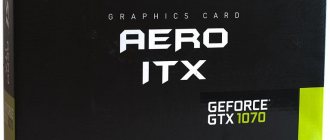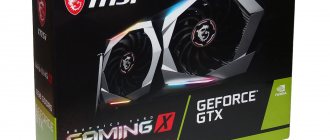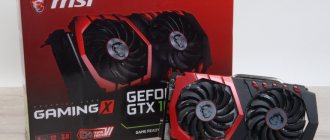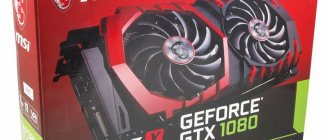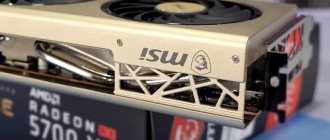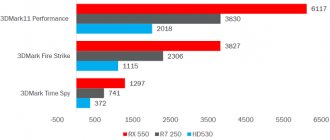Along with the announcement of the GeForce GTX 1080 Ti, Nvidia introduced new versions of the GeForce GTX 1060 and GeForce GTX 1080 video cards. The change in performance was achieved through the use of faster video memory - the effective frequencies of the chips were increased from 8 to 9 GHz for the GeForce GTX 1060 and from 10 to 11 GHz for GeForce GTX 1080.
The editors of our site just got this version of the GeForce GTX 1060 video card from MSI - MSI GeForce GTX 1060 GAMING X+ 6G. Let's find out what it can do and what the differences are from the previous version.
Packaging and equipment
The video card comes in a box that looks familiar to us from one of our previous reviews. As we see, there are not many differences.
It is worth paying attention to the name of the video card. To the familiar Gaming X, a post-index Plus has been added, indicating the use of new GDDR5 video memory chips. The inscription 9 Gbps GDDR5 tells us exactly this.
The package contents have also remained unchanged: brochures, instructions, installation disk and stickers. There is no additional power adapter.
The kit is not rich, but MSI often holds promotions together with Nvidia, and sometimes you can get AAA games for buying a video card, so keep an eye on the events on the websites of these companies.
Conclusion
Overall the map turned out very good. It is well overclocked from the factory and has a good cooling system for the 1060 line.
It will perform great in mining. Even though the GAMING X PLUS is the most expensive among MSI's own 1060 lineup, it's worth buying as it's the coolest and the most overclocked among them.
Its only disadvantage is its dimensions: if you plan to seriously engage in mining at home (assemble several rigs), then you will simply fill half of the apartment with farms from GAMING X PLUS.
Although the card uses little power and is cheap, it is much less profitable than the latest card, the 1080 TI. If you were to build farms on 1080 TI at once, you would install fewer cards in your apartment and get the same hashrate, and possibly more.
pros
- Good cooling
- Low power consumption
- Price
Design and features of the video card
The appearance of the video card does not make it stand out among the Gaming X series. It seems that this is the same MSI GeForce GTX 1060 GAMING X 6G.
The main difference is again the Plus inscription on the rear reinforcement plate. The video card, as before, occupies two slots, making do with the old TWIN FROZR VI cooling system.
The 8-pin additional power connector is in place.
On the back of the video card there are video output connectors: three DisplayPort (version 1.4), one HDMI (version 2.0) and a DVI-D connector.
This video card (like other video cards of modern generations) does not have analog video outputs. You should keep this in mind when buying yourself a new video card. Ordinary adapters will not help here; there is a chance that everything will work correctly with an active adapter, but it is better to have a monitor with a digital input in stock.
The dimensions of the video card have not changed: 277 x 140 x 39 mm with a weight of 1017. The dimensions of the video card will ensure compatibility with most cases, and the low weight, combined with the reinforcing rear plate, will eliminate the possibility of the video card sagging.
Energy consumption and downvolting
The maximum power consumption of a video card is 120-140 Watts (depending on the algorithm), where 70 goes through the PCI-e line (riser), and the rest through the 8 Pin power connectors that come from the unit.
For a farm of 6 cards + connected system, you can safely take a 1000 Watt power supply.
It turns out:
(120*6)+100 = 820 Watts - maximum consumption of a farm of 6 cards and a system (motherboard, hard drive, processor).
A 1000 Watt unit leaves a good margin for stable operation of the farm.
If it is more convenient for you to power it with 2 blocks (you can find out how to run two blocks here), then 2*700 Watts will do. Since smaller units are most often not modular or have 1-2 PCI-e wires.
You can select a block for mining here.
If you need downvolting, then the card, when overclocked on the core +100 and memory +1000, loses only 0.5-09 Mh/s on the Ethash algorithm, and consumes 20 Watts less!
What is downvolting? This is a means by which the energy consumed by the video card is underestimated.
Cooling system and circuit board
In order to remove the cooling system, you need to unscrew the 4 screws located in the GPU area. In the next photo they are highlighted with red circles.
Please note that one screw has a warranty seal. Although MSI does not consider breaking the seal a reason to void the warranty, be careful and think several times before disassembling the video card. Let's immediately make a reservation about the thermal interface - replacing the original thermal paste with Arctic Cooling MX-2 did not yield a single degree of gain.
Having unscrewed the screws and disconnected the connections J1012, J1011 and J200 (by the way, it is quite difficult to disconnect them the first time), we observe the cooling system and... the cooling system.
Most of the board is covered with a protective plate, which acts as a radiator that removes heat from the memory chips and power subsystem. In order to remove this plate, you need to unscrew the remaining screws on the side of the rear plate (the backplate and frontplate are tightened quite tightly), and two more screws on the side of the video output connectors.
Thermal pads are located on all elements that actively heat up when the video card is operating.
The back plate, unfortunately, does not have thermal pads. And their presence would have a good effect on heat dissipation.
The cooling system casing can be removed from the radiator by unscrewing all the necessary screws.
Three heat pipes (two pipes with a diameter of 6 mm and 10 mm) transfer heat from the nickel-plated plate to the radiator, which is blown by two 100 mm proprietary MSI Torx fans (marked PLD10010S12HH, double ball bearing, from 0 to 2500 rpm), which have already repeatedly shown themselves to be positive .
For dessert - a printed circuit board.
MSI's own development has not undergone any changes. 5+1+1 power system, PWM controller uP9511P is responsible for powering the graphics processor, uP1641P is responsible for powering the memory chips. Military Class component base, one additional power connector (8-pin). The first difference that catches your eye is that the MSI GeForce GTX 1060 GAMING X+ 6G has 6 K4G80325FB-HC22 video memory chips, while the GAMING X has K4G80325FB-HC25.
It was thanks to them that the effective frequency of the video card reached 9 GHz, and the MSI GeForce GTX 1060 GAMING X video card received the Plus prefix. We will soon find out why they are so good.
The printed reverse side looks somewhat more modest.
As mentioned above, there are not enough thermal pads in the VRM and GPU area to dissipate heat to the back plate. We hope that someday they will appear there.
Temperatures and internal structure
- Length – 27 cm.
- Noise – 37dB
- Weight – 850 Gr.
The card is equipped with 2 massive coolers, which, according to the developers, protect against dust.
However, after 2 months of mining in the farm, the inside of the card becomes heavily covered with dust. So it's just marketing.
We advise you to blow dust off your cards once every 2 months to make it easier for the coolers to work and to prevent the card from overheating.
Having removed the cooler, we see the radiator grille and copper heat pipes with a diameter of 8 millimeters. The grill itself is a massive nickel-plated copper plate. It collects heat, gives it to thermal tubes, and they, in turn, remove it.
The circuit board is located under the radiator grille. On it we see additional cooling plates that cover the memory and VRM.
Having disconnected it, we see a bare printed circuit board. Let us immediately note that there are no additional thermal stickers under the plates, which would provide, although not much, additional cooling of the memory and VRM.
There are no questions about the board itself; it is based on the Military Class IV standard. Yes, this is marketing, but still the parts perform well at high temperatures.
As for the back side, there is a metal backplate that does not fit tightly.
Measuring a map with a thermal imager
Thermal images show the following result:
| Measuring point | Degrees Celsius) |
| M1 | 59.1 |
| M2 | 55.7 |
| M3 | 44.4 |
| M4 | 47.9 |
| M5 | 38.7 |
| M6 | 39.8 |
| M7 | 25.7 |
M1 – GPU (chip), reaches almost 60 degrees.
The backplate skews the readings so we can't give exact numbers on the VRM (power supply area of the card), but the area doesn't seem hot.
| Measuring point | Degrees Celsius) |
| M1 | 54.7 |
| M2 | 43.4 |
| M3 | 49.9 |
| M4 | 40.6 |
| M5 | 26.3 |
| M6 | 26.1 |
| M7 | 25.6 |
In this image we see hot spots at the top of the map - residual heat. The hottest spot is M1. We can safely say that the coolers handle heat dissipation well.
| Measuring point | Degrees Celsius) |
| M1 | 54.4 |
| M2 | 52,9 |
| M3 | 51,1 |
| M4 | 43,9 |
| M5 | 26,7 |
| M6 | 26.1 |
Most of the heat is concentrated at point M1. A little heat escapes from the VRM, not at all critical.
The general position of the pictures can be assessed as excellent!
However, it is worth noting that all tests were carried out with just 1 card inserted into the motherboard, at room temperature of ~26 degrees.
Therefore, when this card is in a farm (let’s say from 4-6 cards), they will heat each other, and in general the temperature in the room will rise slightly. This means that the temperature of the card itself will increase, but not at all critical. Even in a tightly installed rig, the temperature will not exceed 70 degrees.
However, it is still advisable to additionally blow the farm to dissipate the heat!
Specifications and software
The MSI GeForce GTX 1060 GAMING X+ 6G video card is based on the GP106-410-A1 graphics processor, while its predecessor was content with the GP106-400-A1.
Chips were produced in the 3rd week of 2022 in Taiwan. As you know, these chips are sold only with new memory and in limited quantities.
| Name | MSI GeForce GTX 1060 GAMING X 6G | MSI GeForce GTX 1060 GAMING X+ 6G |
| GPU | GP106-400-A1 | GP106-410-A1 |
| Technical process | 16 nm | 16 nm |
| Kernel size | ~330 mm2 | ~330mm2 |
| Base clock speed | 1569 MHz (Gaming mode) 1594 MHz (OC mode) 1506 MHz (Silent mode) | 1569 MHz (Gaming mode) 1594 MHz (OC mode) 1506 MHz (Silent mode) |
| Boost clock speed | 1784 MHz (Gaming mode) 1809 MHz (OC mode) 1708 MHz (Silent mode) | 1784 MHz (Gaming mode) 1809 MHz (OC mode) 1708 MHz (Silent mode) |
| Number of CUDA cores | 1280 | 1280 |
| Number of texture blocks | 80 | 80 |
| Number of rasterization blocks | 48 | 48 |
| Memory type | GDDR5 | GDDR5 |
| Memory performance | 8 Gbps | 9 Gbps |
| Memory | 6 GB | 6 GB |
| Memory bus bandwidth | 192 bit | 192 bit |
| Additional power connectors | 8 | 8 |
| Power consumption | 120 W | 120 W |
| Dimensions (LxHxW) | 277 x 140 x 39 mm | 277 x 140 x 39 mm |
| Video outputs | DisplayPort 1.4 (2 pcs), HDMI 2.0 (1 pc), DVI-D (1 pc). | DisplayPort 1.4 (2 pcs), HDMI 2.0 (1 pc), DVI-D (1 pc). |
The characteristics are unchanged, with the exception of memory bandwidth. From 192 Gb/s it increased to almost 217 Gb/s.
Power limits for the MSI GeForce GTX 1060 GAMING X+ 6G are 200W, expandable to 216W.
This is enough not only for everyday use, but also for experiments with overclocking.
The video card, like the entire Gaming line, is supported by the MSI Gaming APP program.
This program does not shine with functionality, but many issues can be solved with its help.
For example, initially the video card operates in Gaming mode.
At a temperature of 30-45°C, the turbo frequency is 1974 MHz; with increasing temperature, the frequency gradually decreases by a couple of steps. The memory frequency is at 2257 MHz (9028 MHz effective frequency). You can switch to OC mode using MSI Gaming APP:
In this case, the core frequency in Boost 3.0 mode reaches 2000 MHz, and the memory frequency increases to 2282 MHz (9128 MHz effective frequency). In Silent mode:
The core frequency under the same conditions drops to 1911 MHz.
You can also disable Zero Frozr technology in the application (when the function is enabled, the fans of the video card cooling system are inactive until 60-62 ° C). In this case, the fans begin to constantly rotate at 36% (~ 700 rpm) of maximum speed.
The video card backlight can be adjusted (as well as turning it off completely):
The panel with the company logo is equipped with RGB backlighting, which can operate in several modes. The lighting itself looks unobtrusive.
The backlight on the front of the video card is only red, and it also does not hurt the eyes and looks organic.
It is possible to monitor the main indicators of the video card directly in the gaming application.
Adjustable color gamut for those who don't like to adjust their monitor when switching from watching videos to working with documents or playing games.
In the extensions window...
... there is a Cooler Boost button. Pressing it will lead to a short-term increase in the speed of the video card fans to the maximum value, thereby reducing the temperature readings.
Comparison of MSI Gaming X Plus with analog video card line
The difference between the manufacturers of this line of 1060 6 GB versions is almost minimal.
It will consist of cooling, which is not very important in almost all cards, since the cards do not consume a lot of electricity.
However, it is worth noting that single-cooler video cards will be a little hotter, so MSI Gaming x PLUS wins in this regard and cools cards better than others with 1 cooler, and in general is almost on the same level as dual-cooler ones.
The second difference is the acceleration from the factory. Here MSI is almost in the lead, since it is well overclocked and out of the box it produces a little more in mining than many other video cards. Difference between 1060 6 GB and 1060 3 GB
The difference between the 1060 6 GB version and the 1060 3 GB version is already very large.
For example, on a 6 GB version of a video card you can solve much more algorithms than on a 3 GB version.
Plus, the 3 GB series is much weaker in mining: buying it for a farm in 2022 is not a very profitable solution (only if they cost you nothing or if you use a home card from your PC).
For example, the Zhash algorithm (3 GB version) at maximum overclocking will produce 20 Sol/s versus 24 Sol/s (6 GB version).
Difference between MSI GAMING x PLUS, MSI ARMOR, MSI Aero and MSI Gaming
The difference between cards from the same manufacturer of the same line is almost minimal.
The MSI GAMING x PLUS is the coolest of all these cards and the most overclocked from the factory.
As for cooling, this is very good despite the fact that the temperatures of the cards in mining are not particularly high for this series. But regarding overclocking there is no big difference, since you can always overclock the video card at your convenience through Afterburner.
MSI Aero is the hottest of these cards. If you compile a temperature rating, then Gaming x Plus is best balanced, Gaming is in second place, Armor is in 3rd place, and Aero is in 4th place.
Test bench
- Motherboard: ASUS X99-A II (BIOS 1504);
- Processor: Intel Core i7-5960X Extreme Edition “Haswell-E” 3000 MHz overclocked to 4500 MHz at 1.28 V;
- Cooling system: self-assembled life support system;
- Thermal interface: Arctic Cooling MX-2;
- RAM: 4 x 8 GB Corsair Vengeance LED DDR4-3000 (CMU16GX4M2C3000C15R; 13-15-15-28 CR1);
- Video card: MSI GeForce GTX 1060 GAMING X+ 6G /Nvidia GeForce GTX 10606 GB GDDR5
- Power supply: Corsair RM1000i 1000 Watt;
- System storage: SSD Samsung 850 Evo 250 GB;
- Case: Thermaltake Core X5 Riing Edition.
Software:
- Operating system: Windows 10 x64 “Professional” with all current updates from Windows Update;
- Video card driver: Nvidia GeForce Game Ready Driver WHQL 382.05.
Cooling system testing and overclocking
The cooling system was tested using the Firestrike stability test from the Futuremark 3DMark package. The room temperature was 24-26°C, the side cover of the case was open.
At a frequency of 1974 MHz and a voltage of 1.062 V, the peak temperatures of the video card reached only 63°C, and the fan speed did not exceed 850. This is provided that the fans just started at 61°C!
Similar testing was also carried out when switching the video card to OC modes...
... and Silent.
As we can see, nothing has changed fundamentally, not even the peak consumption of the video card. Excellent result. It is possible that the fine-tuning of chip production has led to them becoming colder, but in any case the cooling system shows itself from a strong position. I wonder what the results will be if you set the speed of the video card fans to a low value, when the noise from them will merge with the noise of case fans and hard drives? Let's find out.
At 1250 rpm, the temperature of the video card did not exceed 57°C, the frequency of the video card core did not drop by a single megahertz.
A study of the potential of the cooling system led to the following result:
At maximum speed (~2500 rpm), the video card was unable to overcome the 50°C bar, stopping at 48°C. It is worth noting that in this mode the noise from the video card is felt quite strongly, but the test itself makes it clear that manually adjusting the fans allows you to achieve low temperatures with low noise levels.
With factory overclocking, the video card received the following results in tests of the 3DMark application suite.
Excellent results, but the video card clearly has a high safety margin. To check this using MSI Afterburner 4.3.0...
...we were looking for those frequencies and voltages at which the video card would be stable and there would be no graphic artifacts in the image. As a result, the following results were achieved:
The core frequency in Boost 3.0 mode reached 2177 MHz at 1.075 V, and the memory frequency was increased to 2582 MHz (10348 MHz effective). At the same time, the consumption of the video card increased by only 10% (~20 W), and the temperatures did not change. This is provided that the fans remain at factory operation.
The following results were obtained in tests of the 3DMark application suite:
The performance of the video card has increased by 9-10%, which is not so little for a factory overclocked video card.
The consumption of the video card was also measured using NVSMI.
As we can see, with factory overclocking the average consumption of the video card was 127 W, peak consumption was 131.5 W. In manual overclocking mode, the average consumption increased to 145 W, the peak was fixed at 153 W. Still, the 2022 chip is different from its counterparts. But for accurate conclusions it is necessary to have more copies of video cards.
In addition to overclocking, it was decided to reduce the memory frequency. This was done using MSI Afterburner.
The results in 3DMark have naturally changed.
Compared to factory overclocking, the results changed by 4-6% downward. In principle, that’s all the difference in performance from older versions of the GTX 1060. But it’s worth considering that changing only one video memory bandwidth does not have such a strong effect on gaming performance; the greatest increase will be provided by the combined overclocking of the core and video card memory.
A key feature of the Gaming series video cards with the TWIN FROZR VI cooling system is separate cooling of the GPU, memory and power subsystem. The plate covering the chips is very convenient for installing a universal water block. We couldn't miss such a chance.
Unfortunately, the plate is quite easily soiled, and to remove marks it is necessary to use moistened wipes.
With this option, one small fan blowing the plate is enough to prevent it from overheating under load.
In the case of water cooling, it was not possible to raise the temperature of the GPU above 40°C.
Overclocking
Of course, we were curious to check the frequency potential of the GeForce GTX 1060. For experiments, we used the MSI Afterburner application.
The Power Limit value in this case can be increased to 108%. There is no way to change the kernel supply voltage, at least the current version of the utility does not provide it.
The GPU frequency was further increased to 1700 MHz. If we take into account the base recommended value of 1506 MHz, the increase is almost 13%. We managed to speed up the memory chips very well. The chips operated at an effective 9528 MHz, which was 19.1% above nominal.
After overclocking, the GPU temperature rose to 67 degrees, and the fan speed barely exceeded 1000 rpm. At its peak, the graphics chip clock reached 2100 MHz. That is, the working delta of the GPU Boost mechanism in this case is about 400 MHz.
Gaming Performance
In games without a built-in test application, the minimum and average frames per second readings were recorded using the Fraps program with the following settings:
Game tests were carried out in resolutions of 1920x1080 and 2560x1440 with maximum graphics settings, only the anti-aliasing settings were changed depending on the resolution.
For the games Battlefield 1, Crysis 3, The Witcher 3 Wild Hunt, Sniper Ghost Warrior 3 and Watch Dogs 2, the following game segments were used (monitoring on them has nothing to do with the video card in question):
The following results were obtained:
As we can see, in modern games, the MSI GeForce GTX 1060 GAMING X+ 6G provides a high level of performance in FHD resolution, and stable 60 frames per second can be achieved with some manipulations with the settings, while losing almost nothing in picture quality. For a resolution of 1440p, this video card will not be enough, and given that SLI is not supported on GeForceGTX 1060 video cards, you will have to look for the ultimate settings.
What coins can you mine?
In this case, it no longer matters what manufacturer the video card is: for the entire line of 1060 6 GB version, it is profitable to mine the Ethash and Neoscrypt algorithms.
There is almost no difference between these algorithms, since at any moment the rate of any coin of the NeoScrypt algorithm can rise and it will be in 1st place in the calculator for 1060 series cards. The same is true vice versa, so there is almost no difference in these algorithms.
However, we note that not all coins are profitable to mine even with these algorithms (which are well tailored for this map).
It is also sometimes profitable to mine other algorithms, for example, when the difficulty of a certain coin drops significantly or (as in the example above) the exchange rate begins to rise.
Also note that there are coins that are completely unprofitable to mine on this video card.
Mined coins
| Algorithms | Coins |
| NeoScrypt | Crowdcoin, Dinero, Feathercoin, GoByte, Halcyon, Innova, Vivo, Trezarcoin, Orbitcoin, Phoenixcoin |
| Zhash | Zelcash, BitcoinZ, BitcoinGold |
| CryptoNightV7 | Monero, Electroneum |
| Ethash | Ethereum, Ethereum Classic, Ellaism, Metaverse, Expanse, Krypton, Ubiq, Soilcoin, Shift, Pirl, Musicoin |
| TimeTravel10 | Bitcore |
| Lyra2REv2 | Monacoin, Galactrum, Rupee, Straks, Vertcoin, Verge |
| Equihash | Zclassic, Hush, Zcash, Zencash, BitcoinGold, Komodo, BitcoinZ, Bitcoin Interest, Bitcoin Private, BitcoinZ, Zero |
| X16R | Ravencoin |
| Lyra2z | Actinium, Alpenschilling, Criptoreal, GINcoin, Infinex, MCT+, Taler, Respawn, STIM COIN, Taler, Vertical, Zcoin |
for these coins you can on our website. We have also created for you fully configured and ready-made Bat files for all of the above coins.

